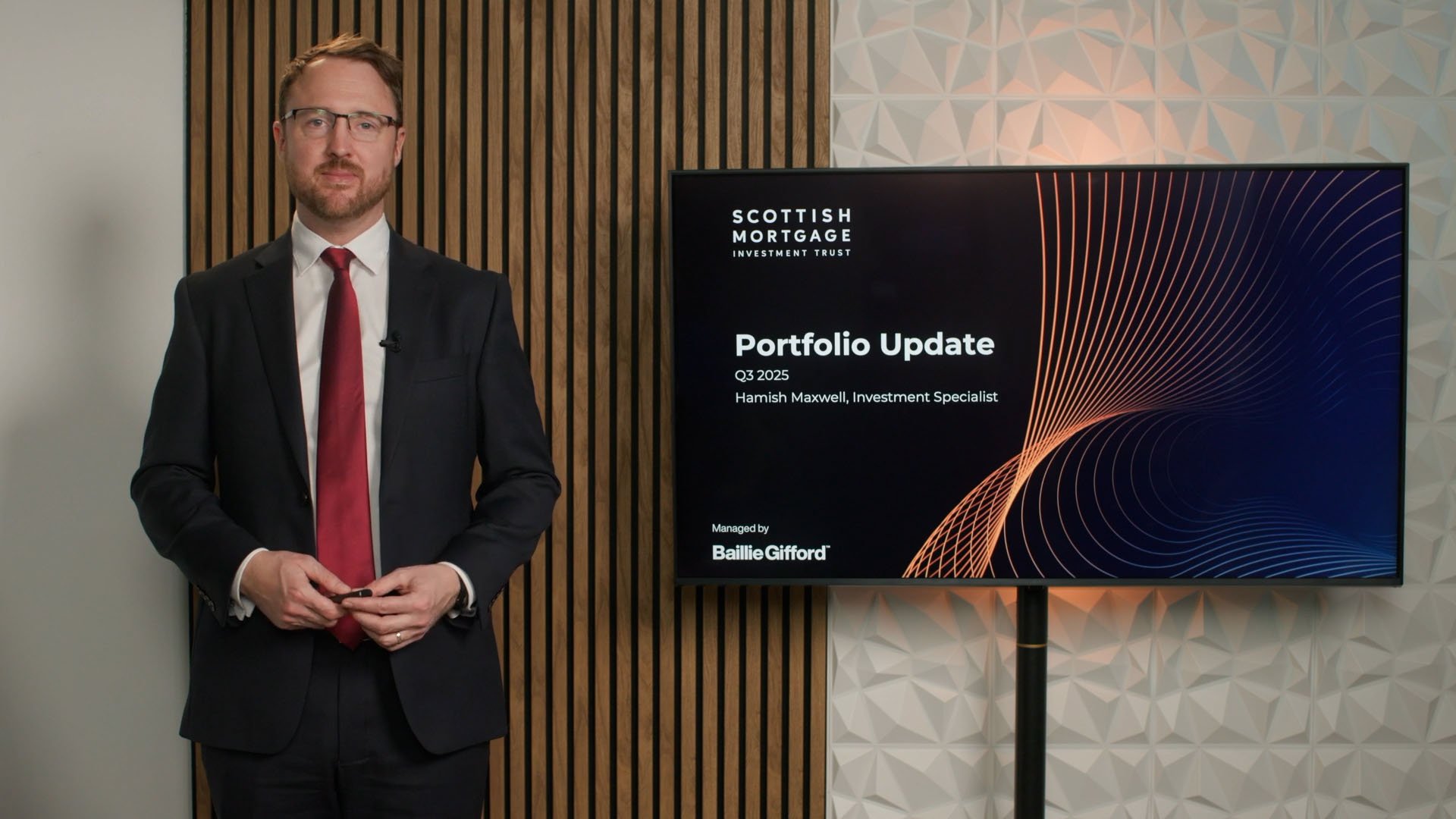Back to Blue Sky and Base Rates: 10 Years On
Tom Slater – Manager, Scottish Mortgage
Key Points
- A decade after his influential study of shareholder returns, Tom Slater reflects on its thesis that backing transformative companies is key to outperformance
- His refreshed analysis underlines the benefits of focusing on a small number of high-growth winners
- Success, Tom argues, stems from allocating capital to unproven ideas, not chasing market consensus

As with any investment, your capital is at risk.
About 10 years ago, exploiting my inner maths geek, I decided to examine the evidence for what really matters in long-term growth investing. I took a break from my usual company-level view of outperformance and looked at the broader stock market. The result was a paper called 'Blue Sky and Base Rates'.
My goal was to understand how market returns were structured, in the hope of improving how we make investment decisions. Specifically, I wanted to explore how some stocks deliver huge gains over time, while many don't and may even lose value. How did this imbalance or ‘asymmetry’ shape long-term outcomes?
By studying the historical returns of the S&P 500, I looked at how often stocks increased significantly in value over five-year periods, helping me identify patterns and calculate what are called base rates – the likelihood of certain outcomes based on past performance.
The analysis aimed to refine how we imagine possible futures for companies. I explored how a few big winners can drive the overall success of a portfolio, examining what factors like sales growth and sector trends were common to those top-performing stocks. I’ll come back to those findings, but first, some reflections on the wider context.
A Decade of Perspective
A week, famously a long time in politics, can seem an eternity in financial markets. Valuations can lurch wildly within a matter of days. But if you're trying to build something meaningful, a week is a vanishingly short window through which to view the world.
Rome was not built in a day. Henry Ford's mass production assembly lines at River Rouge took around 15 years to complete. SpaceX's super heavy booster and network of 7,000 Starlink satellites have taken upwards of that.
These well-known journeys of growth encountered many difficult moments along the way and dreams had to be rebuilt. What mattered was the focus on big future gains.
Considering just how difficult it is to turn a grand vision into something real and valuable, it makes sense that growth should be measured over periods of at least 10 years. That's certainly what our experience tells us.
A Century of Learning
Only one in 10,000 companies survives to be 100 years old. With over 116 years of experience, Scottish Mortgage and of course its manager, Baillie Gifford, are among that small cohort of companies to surpass a century in age. That implies the ability to navigate difficult times.
Our share price chart going back over a century shows that despite inevitable periods of volatility – such as the 1970s oil shock, the great financial crisis, the dotcom bubble and the post-Covid period – Scottish Mortgage has been an extremely successful long-term investment.
In an industry where everyone has access to the same data and therefore tends to reach similar conclusions, the characteristics that have helped us include distinctiveness, stability and adaptability.
Distinctiveness comes from perspective. It comes from courage, from hard-won experience, from questioning the prevailing orthodoxy. It comes from accepting that we’ll often look wrong in the moment. It comes from a culture wherein seeming to be ‘wrong’ isn't just tolerated but valued.
Stability comes from the deep rootedness of that culture, from long-termism, from prioritising shareholders and being guided by an independent, experienced board.
Adaptability is essential. That means identifying long-term growth themes, investing in companies with the leadership that can exploit them: companies with flexible strategies, resilient financial foundations and innovation at their heart.
Markets Don't Stand Still
One reason we've done a good job for investors over 100 years is by constantly learning and improving. The volatile ride of the past five years has been a chance to reflect and consider the lessons. Has something changed? Has the return structure of markets moved on? Has the opportunity in growth investing been arbitraged away?
The market's attention span is typically short. Last year, it was elections and inflation. This year, it's tariffs and trade wars. Next year… who knows? We need to be able to look through that.
But on the other hand, we rely on following valuable long-term trends such as:
- AI deployment, which has propelled AI-hardware specialist NVIDIA
- the digitisation of the economy, which underpins growth for south-east Asia’s ecommerce giant Sea Ltd or Latin America's fintech pioneer Nubank
- electrification in transportation, powering electric and soon to be autonomous vehicles by BYD
Notwithstanding the strength of such forces, we’ve seen a steep drawdown in growth equities. We've seen the emergence of the Magnificent Seven and rising market concentrations. How then should we reconsider that 2014 market analysis in the light of 10 more years of data?
This question led me to recently renew my 2014 analysis. Markets have changed. We wanted to know by how much.
The Persistence of Skew
In Daniel Kahneman's famous book Thinking, Fast and Slow, he looks at probability structures that underlie decision-making. As an investment manager, the key decisions I must make are which stocks to buy and when. In a complex world, I'm trying to support those decisions using concepts such as base rates and scenario analysis.
When I did my original study, looking at data from 1984 to 2013, it revealed that about 20 per cent of companies create half of the return. Furthermore, it showed that only 5 per cent of stocks grew at least five-fold in any five-year period. There was a small number of big winners that drive most of the returns.
One of the most compelling findings from my recent update is the persistence of skew in equity returns. Just as in the 2014 data, a small number of companies has continued to drive most of the market gains. It's interesting that in a much broader index over a completely different time period, we see the same return structure. Again, over the past decade, 20 per cent of the companies drove about half of the return. The top 5 per cent of companies returned at least four and a half fold.
It remains true that, when seeking the best returns, only a few companies actually matter. That skew doesn’t bother us. In fact, it’s the source of our investment edge. It underlies why we continue to back a small number of businesses with the potential for transformative outcomes.
Running our Winners
How has that skewness come through in our portfolio? Stock ranking has been an important differentiator. We've ‘run our winners’. To invest in high growth is to believe that the world will change for the better. That belief, tempered by judgement but undimmed by cynicism, is what underpins all our investments. We think critically, but about what might go right, not what could go wrong.
The blue circles representing our largest holdings over the past decade show they've returned several times their value. Along the bottom, you can see all of our worst investments. We pick stocks that have gone to zero – trucking company Convoy and battery-maker Northvolt most recently. But what is crucial is the payoffs: what you make when you win versus what you lose when you get it wrong.
That's the skew that's driven returns. The likes of NVIDIA, Spotify, home delivery leader Meituan and space logistics and satellited internet company SpaceX have created substantial upside. Meanwhile, the impact of the losers does not exceed the size of the investment and has therefore been much more limited.
Fundamentals Drive Returns
Another of our core beliefs was reinforced by the new analysis: that long-term returns are fundamentally driven by factors such as revenue growth. Piercing through the cacophony of market noise are the companies that deliver real business progress. That ultimately reward patient investors.
When we bought NVIDIA back in 2016, many considered it just a gaming hardware company. We saw the potential for its chips in autonomous cars, in cryptocurrency, in AI, and it's gone on to deliver trillions of dollars of upside thanks to those AI chips. We took substantial profit from the holding last year.
Since we bought a holding in the Chinese food delivery company Meituan as a small private company, it's grown to the point where it's often delivering as many meals each day in China as there are people in the UK. It's now expanding rapidly into new categories and new countries.
The Power of Time
One of the most under-exploited assets in investing is time. Many of the top-performing companies only emerge as such over five to 10 years. We humans are naturally not very patient. We often prefer immediate gratification – the legacy perhaps of our evolutionary origins, when we used to lack full control of our food supply. Share prices are heavily influenced by short-term noise. Turnover data indicates that the market's time horizon extends to one-to-two years at best.
With our 10-year horizon, we aim to already own growing businesses by the time the market is ready to recognise them. By resisting the temptation for short-term trading, we allow compounding to work its quiet magic.
Scottish Mortgage Average Holding Period
This approach is especially powerful in backing businesses that are creating an industry rather than competing with existing players, because the market struggles to value such opportunities. Artificial intelligence, autonomous driving, reusable space rockets: these things don't happen overnight. They take years to build, and there'll be mistakes along the way.
Global Opportunities and Sectoral Evolution
Our updated analysis also considered sectors and geographies.
In terms of sectors, information technology and consumer discretionary companies have continued to dominate the top outcomes. Whereas healthcare has dropped out of the top spots, perhaps reflecting the challenge of rising interest rates and drug pricing concerns. Industrials saw a renaissance, perhaps reflecting strong demand for goods through the Covid period and substantial infrastructure investment.
On geography, the highest concentration of top-performing companies was in the US and China,. This helps explain our persistence in investing in China when so many other investors have given up on it. Furthermore, and crucially, outliers do exist across regions. The world is rich with investment opportunities – from AI in the US to precision engineering and luxury goods in Europe, tech giants in Asia and Latin America. Hence our unconstrained approach and Baillie Gifford’s global body of research.
What are the Implications for our Strategy?
Revisiting my original research, and reconsidering it in the light of a decade’s further experience of the highs and lows of investing, has reinforced some core beliefs about what’s needed to survive and thrive in this business. I’d summarise the lessons as follows:
- Maintain a long-term investment horizon, in companies whose transformative potential might take 10 years to be realised
- Remember the power law (potential orders of magnitude of growth) in market returns and back only a few exceptional companies that can potentially deliver substantial returns
- It’s robust fundamentals, such as rapid sales growth and increasing profitability that determine top performers
- Keep a global perspective: an unconstrained approach can best capture exceptional growth companies worldwide
- Embrace the non-obvious: distinctive investment demands the ability to cut out market noise
The Foundation of Long-term Success
On that last point on the above list: being distinctive is essential, but it’s also difficult. Everything around us encourages convergence. It takes deliberate, sustained effort to stand apart, to resist being enveloped by the surrounding environment. Yet for high-growth investors, distinctiveness is non-negotiable. It isn't a style or preference. It's the foundation of long-term success.
Scottish Mortgage is not in the business of chasing consensus. We're in the business of allocating capital to outcomes that haven't yet been proven, and to companies that don't just seek to compete, but to create. That kind of investing is inherently uncomfortable. It demands imagination, patience and a tolerance for being misunderstood.
Focusing on what matters and constantly trying to learn and improve has stood us well for 100 years. I think it continues to prepare us well for the future. In the ever-evolving investment landscape, patience and a focus on growth remain guiding principles. As history has shown, meaningful growth is not achieved overnight, but through steadfast commitment to a long-term vision.
Annual Past Performance To 31 March each year (net %)
| 2021 | 2022 | 2023 | 2024 | 2025 | |
| Share Price | 99.0 | -9.5 | -33.6 | 32.5 | 6.0 |
| NAV | 111.2 | -13.2 | -17.8 | 11.5 | 11.4 |
| Benchmark* | 39.6 | 12.8 | -0.9 | 21.0 | 5.5 |
Source: Morningstar, total return, sterling. *FTSE All World Index (GBP).
Past performance is not a guide to future returns.
Risk Warnings
The Trust invests in overseas securities. Changes in the rates of exchange may also cause the value of your investment (and any income it may pay) to go down or up.
Unlisted investments such as private companies, in which the Trust has a significant investment, can increase risk. These assets may be more difficult to sell, so changes in their prices may be greater.
The Trust invests in emerging markets, which includes China, where difficulties with market volatility, political and economic instability including the risk of market shutdown, trading, liquidity, settlement, corporate governance, regulation, legislation and taxation could arise, resulting in a negative impact on the value of your investment.
Legal Notice
London Stock Exchange Group plc and its group undertakings (collectively, the “LSE Group”). © LSE Group 2019. FTSE Russell is a trading name of certain of the LSE Group companies. “FTSE®" and “Russell®” are trademarks of the relevant LSE Group companies and are used by any other LSE Group company under license. “TMX®” is a trademark of TSX, Inc. and used by the LSE Group under license. All rights in the FTSE Russell indexes or data vest in the relevant LSE Group company which owns the index or the data. Neither LSE Group nor its licensors accept any liability for any errors or omissions in the indexes or data and no party may rely on any indexes or data contained in this communication. No further distribution of data from the LSE Group is permitted without the relevant LSE Group company’s express written consent. The LSE Group does not promote, sponsor or endorse the content of this communication.
About the author - Tom Slater
Manager, Scottish Mortgage
Tom Slater is manager of Scottish Mortgage. He joined Baillie Gifford in 2000 and became a partner of the firm in 2012. Tom joined the Scottish Mortgage team as deputy manager in 2009, before assuming the role of Manager in 2015. Beyond that, he is the head of the US Equities team and a member of another long-term growth equity strategy. During his time at Baillie Gifford, Tom has also worked in the Developed Asia and UK Equity teams. Tom’s investment interest is focused on high-growth companies both in listed equity markets and as an investor in private companies. He graduated BSc in Computer Science with Mathematics from the University of Edinburgh in 2000.
Regulatory Information
This content was produced and approved at the time stated and may not have been updated subsequently. It represents views held at the time of production and may not reflect current thinking. Read our Legal and regulatory information for further details.
A Key Information Document is available by visiting our Documents page. Any images used in this content are for illustrative purposes only.
This content does not constitute, and is not subject to the protections afforded to, independent research. Baillie Gifford and its staff may have dealt in the investments concerned. The views expressed are not statements of fact and should not be considered as advice or a recommendation to buy, sell or hold a particular investment.
Baillie Gifford & Co and Baillie Gifford & Co Limited are authorised and regulated by the Financial Conduct Authority (FCA). The investment trusts managed by Baillie Gifford & Co Limited are listed on the London Stock Exchange and are not authorised or regulated by the FCA.
Baillie Gifford Asia (Hong Kong) Limited 柏基亞洲(香港)有限公司 (BGA) holds a Type 1 licence from the Securities and Futures Commission of Hong Kong to market and distribute Baillie Gifford’s range of collective investment schemes and closed-ended funds such as investment trusts to professional investors in Hong Kong.
Baillie Gifford Asia (Singapore) Private Limited (BGAS) is regulated by the Monetary Authority of Singapore as a holder of a capital markets services licence to conduct fund management activities for institutional investors and accredited investors in Singapore. BGA and BGAS are wholly owned subsidiaries of Baillie Gifford Overseas Limited, which is wholly owned by Baillie Gifford & Co.
Europe
Scottish Mortgage Investment Trust PLC (the “Company”) is an alternative investment fund for the purpose of Directive 2011/61/EU (the “AIFM Directive”). Baillie Gifford & Co Limited is the alternative investment fund manager (“AIFM”) of the Company and has been authorised for marketing to Professional Investors in this jurisdiction.
This content is made available by Baillie Gifford Investment Management (Europe) Limited (“BGE”), which has been engaged by the AIFM to carry out promotional activities relating to the Company. BGE is authorised by the Central Bank of Ireland as an AIFM under the AIFM Regulations and as a UCITS management company under the UCITS Regulation. BGE also has regulatory permissions to perform promotional, advisory and Individual Portfolio Management activities. BGE has passported its authorisations under the mechanisms set out in the AIFM Directive.
Belgium
The Company has not been and will not be registered with the Belgian Financial Services and Markets Authority (Autoriteit voor Financiële Diensten en Markten / Autorité des services et marchés financiers) (the FSMA) as a public foreign alternative collective investment scheme under Article 259 of the Belgian Law of 19 April 2014 on alternative collective investment institutions and their managers (the Law of 19 April 2014). The shares in the Company will be marketed in Belgium to professional investors within the meaning the Law of 19 April 2014 only. Any offering material relating to the offering has not been, and will not be, approved by the FSMA pursuant to the Belgian laws and regulations applicable to the public offering of securities. Accordingly, this offering as well as any documents and materials relating to the offering may not be advertised, offered or distributed in any other way, directly or indirectly, to any other person located and/or resident in Belgium other than to professional investors within the meaning the Law of 19 April 2014 and in circumstances which do not constitute an offer to the public pursuant to the Law of 19 April 2014. The shares offered by the Company shall not, whether directly or indirectly, be marketed, offered, sold, transferred or delivered in Belgium to any individual or legal entity other than to professional investors within the meaning the Law of 19 April 2014 or than to investors having a minimum investment of at least EUR 250,000 per investor.
Germany
The Trust has not offered or placed and will not offer or place or sell, directly or indirectly, units/shares to retail investors or semi-professional investors in Germany, i.e. investors which do not qualify as professional investors as defined in sec. 1 (19) no. 32 German Investment Code (Kapitalanlagegesetzbuch – KAGB) and has not distributed and will not distribute or cause to be distributed to such retail or semi-professional investor in Germany, this document or any other offering material relating to the units/shares of the Trust and that such offers, placements, sales and distributions have been and will be made in Germany only to professional investors within the meaning of sec. 1 (19) no. 32 German Investment Code (Kapitalanlagegesetzbuch – KAGB).
Luxembourg
Units/shares/interests of the Trust may only be offered or sold in the Grand Duchy of Luxembourg (Luxembourg) to professional investors within the meaning of Luxembourg act by the act of 12 July 2013 on alternative investment fund managers (the AIFM Act). This document does not constitute an offer, an invitation or a solicitation for any investment or subscription for the units/shares/interests of the Trust by retail investors in Luxembourg. Any person who is in possession of this document is hereby notified that no action has or will be taken that would allow a direct or indirect offering or placement of the units/shares/interests of the Trust to retail investors in Luxembourg.
Switzerland
The Trust has not been approved by the Swiss Financial Market Supervisory Authority (“FINMA”) for offering to non-qualified investors pursuant to Art. 120 para. 1 of the Swiss Federal Act on Collective Investment Schemes of 23 June 2006, as amended (“CISA”). Accordingly, the interests in the Trust may only be offered or advertised, and this document may only be made available, in Switzerland to qualified investors within the meaning of CISA. Investors in the Trust do not benefit from the specific investor protection provided by CISA and the supervision by the FINMA in connection with the approval for offering.
Singapore
This content has not been registered as a prospectus with the Monetary Authority of Singapore. Accordingly, this content and any other content or material in connection with the offer or sale, or invitation for subscription or purchase, of the Trust may not be circulated or distributed, nor may be offered or sold, or be made the subject of an invitation for subscription or purchase, whether directly or indirectly, to persons in Singapore other than (i) to an institutional investor (as defined in Section 4A of the Securities and Futures Act 2001, as modified or amended from time to time (SFA)) pursuant to Section 274 of the SFA, (ii) to a relevant person (as defined in Section 275(2) of the SFA) pursuant to Section 275(1), or any person pursuant to Section 275(1A), and in accordance with the conditions specified in Section 275 of the SFA, or (iii) otherwise pursuant to, and in accordance with the conditions of, any other applicable provision of the SFA.
Where the Trust is subscribed or purchased under Section 275 by a relevant person which is:
(a) a corporation (which is not an accredited investor (as defined in Section 4A of the SFA)) the sole business of which is to hold investments and the entire share capital of which is owned by one or more individuals, each of whom is an accredited investor; or
(b) a trust (where the trustee is not an accredited investor) whose sole purpose is to hold investments and each beneficiary of the trust is an individual who is an accredited investor, securities or securities-based derivatives contracts (each term as defined in Section 2(1) of the SFA) of that corporation or the beneficiaries’ rights and interest (howsoever described) in that trust shall not be transferred within six months after that corporation or that trust has acquired the securities pursuant to an offer made under Section 275 except:
(1) to an institutional investor or to a relevant person or to any person arising from an offer referred to in Section 275(1A) or Section 276(4)(c)(ii) of the SFA,
(2) where no consideration is or will be given for the transfer;
(3) where the transfer is by operation of law; or
(4) pursuant to Section 276(7) of the SFA or Regulation 37A of the Securities and Futures (Offers of Investments) (Securities and Securities-based Derivatives Contracts) Regulations 2018.







